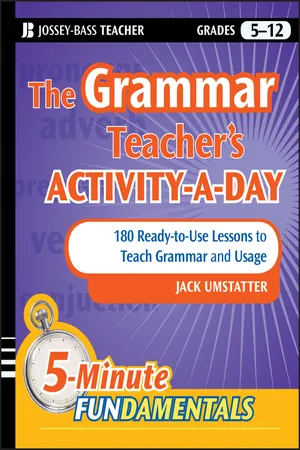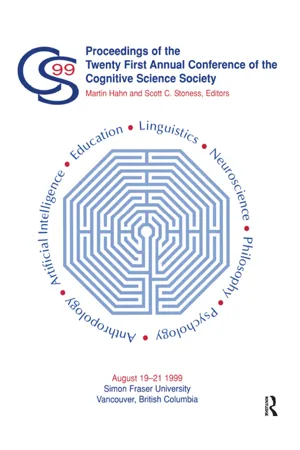Concrete Nouns
Concrete nouns are words that represent tangible, physical objects that can be perceived by the senses. They include things like animals, plants, people, and inanimate objects. Concrete nouns are the opposite of abstract nouns, which represent ideas, emotions, or concepts. In language, concrete nouns help to provide specificity and clarity in communication.
6 Key excerpts on "Concrete Nouns"
- eBook - ePub
Structure and Meaning in English
A Guide for Teachers
- Graeme Kennedy(Author)
- 2014(Publication Date)
- Routledge(Publisher)
...Concrete Nouns are things that can be seen or touched (e.g. a bottle, water, the moon, grass). Abstract nouns are non-material or are not able to be seen or touched (e.g. safety, problem, warmth, idea, education). However, the distinction between concrete and abstract nouns is not important for learning English. Similarly, apples, oranges and pears are all nouns that belong to the class of fruit, but this is also not grammatically important. The most important categories of nouns for learners are those that affect the grammar of sentences. There are five main categories of nouns that affect the grammar of sentences. 1 common nouns which are always countable 2 common nouns which are always uncountable 3 common nouns which can be countable or uncountable 4 common nouns which are collective nouns 5 proper nouns A further group of nouns (‘quantifying nouns’) is used for specifying quantity in English (see Section 4.2.2). 4.1.5 Countable nouns and uncountable nouns The most important grammatical distinction for English nouns is between 1 nouns we can count (e.g. chairs, books, ideas, years, problems) 2 nouns we cannot count (e.g. furniture, water, ice, safety, time) Consider this example of how the class of noun affects other words: a There are n’t as many chairs here as we need, are there? b There is n’t as much furniture here as we need, is there? The form of the verb (aren’t or isn’t), the determiner (many or much) and the tag (are, is) are all affected by whether the noun is countable (chair) or uncountable. (furniture). We perceive some nouns as individual countable units or things, each separate and distinct – a spider, a toothbrush, a pen, a headache, an idea, a name, a meeting, an appointment. We can count them – three spiders, many new ideas, six meetings, etc...
- eBook - ePub
- APS Hundal(Author)
- 2022(Publication Date)
- Green Sceptre Publishing Australia(Publisher)
...Nouns A word or word group used to identify any person, place, thing or an idea. Or Noun is a name of anything as school, garden, kite or king. Its main purpose is to identify any person, place thing or idea. 1. Person: boy, girl, Alexander, Helen 2. Place: England, village, office, apartment 3. Thing: elephant, chair, fan, television. There are several types of nouns in English, most important ones are listed below: Common Noun It is a generic name of any person, place, thing or idea. It is only capitalized in the beginning of sentence or in the title. Common noun can be concrete, abstract or collective. Common noun can be anything like: • Men • Women • Animals • Humans • Queen • Princess The teacher assigned us assignment. I ordered my book online. We are going to play in the park. Doctor recommended these medicines. Boys are playing soccer. Proper noun It is more specific (e.g Elizabeth, Alexander, America, India, London). A proper noun is used to specify a particular person, place or thing. They begin with a capital letter and are used to convey clearer sentence. For instance: • Alexander • Amazon • Russell Park • Amritsar • Al ante Mall • Doctor Fitzergerald Alexander assigned us an assignment. I ordered my book from eBay. We are going to play in Russell Park. Amritsar is one of my favourite places to visit. We are going shopping in AL ante Mall. Doctor Fitzergerald recommended these medicines. Concrete noun These nouns can be experienced physically. They can be easily detected through any one of five senses. They are opposite to abstract nouns. Or Tangible things one can perceive with any one of five senses are Concrete Nouns. Below are few examples of Concrete Nouns. What is all that noise ? This portrait i s very pretty. Snakes are dangerous reptiles. Shakespeare was a great scholar. My house is at the end of this street. Abstract Noun These nouns specify to intangible things such as emotions, qualities, ideas, states, moments, etc...
- eBook - ePub
- Roger Hawkins, Richard Towell(Authors)
- 2015(Publication Date)
- Routledge(Publisher)
...1 Nouns 1.1 Types of noun A noun is a word that typically refers to an entity or concept of some kind, e.g. livre ‘book’, ami ‘friend’, bière ‘beer’, bonheur ‘happiness’, and is the main constituent of the subject of a clause, the object of a verb or the object of a preposition. French nouns may co-occur with articles (le livre ‘the book’, un ami ‘a friend’) and modifying adjectives (un roman français ‘a French novel’, mon cher ami ‘my dear friend’). There are different subclasses of noun, typically determined by meaning, that have different distributional properties which are described in this chapter: abstract (bonheur ‘happiness’, beauté ‘beauty’), concrete (bière ‘beer’, roman ‘novel’), mass (eau ‘water’, beurre ‘butter’), count (bouteille ‘bottle’, billet ‘ticket’), collective (comité ‘committee’, gouvernement ‘government’) and proper (names) (Jean-Pierre, France). French nouns belong to one of two gender classes – masculine or feminine (le bâtiment ‘the building’, but la maison ‘the house’) – and they may vary in form when they are singular or plural (cheval ‘horse’, but chevaux ‘horses’). Nouns can be simple (une cour ‘a yard’, un marteau ‘a hammer’) or compound (une basse-cour ‘a farmyard’, un marteaupiqueur ‘a pneumatic drill’). Compound nouns have their own rules for gender and number assignment (see 1.2.11 and 1.3.9). 1.1.1 Abstract versus Concrete Nouns Concrete Nouns refer to entities with physical attributes which can be seen, heard, touched, etc...
- eBook - ePub
- Jack Umstatter(Author)
- 2010(Publication Date)
- Jossey-Bass(Publisher)
...They are nonspecific. Some singular common nouns include actor (person), lounge (place), stick (thing), and kindness (idea). Plural common nouns include men (persons), head-quarters (places), computers (things), and liberties (ideas). • Proper nouns begin with an uppercase (or capital) letter because they name specific persons, places, things, and ideas. Proper nouns include President Harry Truman (person), Eiffel Tower (place), American Federation of Teachers (thing), and Theory of Relativity (idea). • Concrete Nouns name a person, place, thing, or idea that can be perceived by one or more of your senses (seeing, hearing, touching, tasting, and smelling). Popcorn, thunder, rainfall, skunk, windmill, and hair are Concrete Nouns. • Abstract nouns name an idea, feeling, quality, or trait. Examples of abstract nouns include pity, weakness, humility, and elation. • Collective nouns name a group of people or things. Some collective nouns are squad, assembly, team, jury, flock, and herd. 3 the pronoun The pronoun, the second of the eight parts of speech, is a word that takes the place of a noun. • In the sentence, “Felipe is an intelligent student,” the noun, Felipe, can be replaced by the singular pronoun he. Thus, the new sentence reads, “He is an intelligent student.” • In the sentence, “We offered the baseball tickets to Rita and Drew,” the nouns, Rita and Drew, can be replaced by the plural pronoun, them. The new sentence will now read, “We offered the baseball tickets to them.” There are several types of pronouns. Personal pronouns refer to people, places, things, and ideas. I, me, you, your, they, us, and it are all personal pronouns. Reflexive pronouns are formed by adding “-self” or “-selves” to certain personal pronouns. They “reflect” back to the person or thing mentioned in the sentence. Myself, himself, herself, itself, yourself, yourselves, and themselves are reflexive pronouns...
- Martin Hahn, Scott C. Stoness, Martin Hahn, Scott C. Stoness(Authors)
- 2020(Publication Date)
- Psychology Press(Publisher)
...The finding that concrete words are more readily processed by language users-the “concreteness effect”--has been found in a number of experiments using a variety of tasks (for reviews, see Balota, Ferraro, & Conner. 1991; and Schwanenflugel, 1991; for representative studies that have failed to find concreteness effects, see these same reviews). Concreteness effects have been shown for words presented in lexical decision (Bleasdale, 1987; Chiarello, Senehi, & Nuding, 1987; Ransdell & Fischler, 1987; Schwanenflugel, Harnishfeger, & Stowe, 1988; Schwanenflugel & Shoben, 1983), naming (Bleasdale, 1987; de Groot, 1989; Schwanenflugel & Stowe, 1989), free recall (Paivio, 1986; Ransdell & Fischler, 1987; Schwanenflugel, Akin, & Luh, 1992), and word association (de Groot, 1989). Concreteness effects have also been seen in experimental tasks that involved comprehension or recall of sentences or paragraphs that differed on concreteness (Belmore, Yates, Bellack, Jones, & Rosenquist, 1982; Holmes & Langford, 1976; Ransdell & Fischler, 1989; Schwanenflugel & Shoben, 1983). Given the wealth of evidence that suggests that the processing of concrete and abstract words differs, an explanation of the representational differences between these word types would seem to be essential for any robust theory of word meaning. One potential explanation of this difference is extended by the context-availability model discussed by Schwanenflugel and Shoben (1983; and Schwanenflugel, 1991). This model posits that language comprehension is aided by the retrieval from memory of contextual information associated with the material being processed. If the appropriate contextual information can not be retrieved from memory (and is not provided by some external source, such as a conversation), then comprehension is difficult...
- eBook - ePub
- Philip Holmes, Ian Hinchliffe(Authors)
- 2013(Publication Date)
- Routledge(Publisher)
...Chapter 1 Nouns 1.1 Introduction 1.1.1 Different types of noun Proper nouns: Björn; Stockholm; Sverige, Sweden; IKEA Common nouns: Concrete Nouns: bil, car; dator, computer; hus, house; katt cat; kvinna, woman; stol, chair Abstract nouns: begåvning, intelligence; glädje, joy; mjukhet, softness; sorg, grief; sjukdom, illness Nouns may also be classified as: Count nouns, i.e. concrete things and creatures: bulle, bun; student, student; träd, tree – Some abstracts are count nouns: färg, colour; leende, smile; skratt, laugh Non-count nouns, i.e. substances: bensin, petrol; luft, air; vatten, water – Some abstract nouns are non-count nouns: lycka, happiness; vithet, whiteness. Also: pengar, money. For noun compounds see 11.3.2 – 11.3.5. 1.1.2 Genders Swedish nouns are of one of two genders, non-neuter and neuter shown by the form of the indefinite and definite article (1.9f.). Non-neuter nouns take the indefinite article en and the end article (definite article) - (e)n: en bil, a car en kvinna, a woman bilen, the car kvinnan, the woman Some grammars use the term ‘common’ for ‘non-neuter’. Others use ‘ n -word’ or ‘ en -word’ for the non-neuter noun and ‘ t -word’ or ‘ ett -word’ for the neuter noun. Neuter nouns take the indefinite article ett and the end article (definite article) - (e)t : ett bord, a table ett yrke, a profession bordet, the table yrket, the profession About seventy-five per cent of all nouns occurring in newspaper text are non-neuter. In many cases either the form of the noun, usually its final syllable, or its meaning may provide a clue to its gender. 1.1.3 Indefinite plural forms Plurals are indicated by a number of different endings according to declension...





